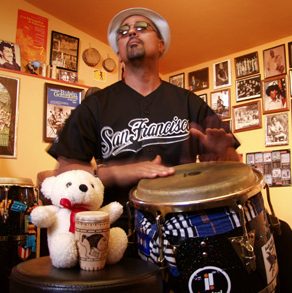From jazz to salsa to samba, the San Francisco Bay Area is a vibrant hub of Afro-Latin music—and one of the reasons is percussionist John Santos, who for 45 years has played an essential role in bringing the full range of Afro-Latin music to a wide audience. On October 3, John—a generous teacher, performer, and recording artist—will join us in an online conversation about some fundamental Latin percussion instruments: tumbadora (conga drum), guiro, claves, cowbell, and chekeré. You don’t need to own any of those instruments–or any percussion instruments at all–to enjoy and benefit from the workshop. Just tapping out the rhythms with John will be valuable for all musicians, percussionists or not. Moderator Dee Spencer will keep the conversation flowing and take your questions.
We chatted recently with John to learn more about his musical background.

What were your early musical influences?
I was born in San Francisco in 1955 into a musical family. My grandparents on both sides were professional musicians—from Puerto Rico on my mother’s side and from Cape Verde on my father’s side. My parents had a large record collection—jazz, Cuban, Puerto Rican—and I also listened to whatever my older brothers and cousins listened to, from Jimi Hendrix and the Beatles to Motown and B.B. King.
In the third grade I began playing a clarinet that I inherited from my brothers. But by sixth grade I was more interested in percussion. I never looked back.
When did you start performing?
My dad had gone to school in San Francisco with some great musicians—Carlos Duran, Manny Duran, Eddie Duran, Benny Velarde, Carlos Federico. The Duran brothers and Benny Velarde went on to play with Cal Tjader’s Latin jazz band. When I was about 14 and playing congas, my dad took me to the clubs where they were playing. I even got to sit in with them. I was underage, but as long as I drank only Shirley Temples no one minded!
Tell us about your musical education.
I learned from Armando Peraza and Francisco Aguabella, two master musicians. [Peraza, who died in 2014, played congas and bongos with the rock band Santana.] I didn’t take formal lessons, but I learned an incredible amount just listening to their stories and watching them play. And in the mid-1980s, after 15 years of my bugging him, I finally persuaded Francisco to give me formal lessons.
I’ve also learned through teaching. Since 1986 I’ve taught at Jazz Camp West—which is now in La Honda, near Santa Cruz—for a week every year. It’s a magical week—nothing but music in the redwoods. Concerts every night. My kids, who are 12 and 15, grew up there. This year, because of the pandemic, we had virtual camp.
Can you recommend a good resource for Latin percussion instruments?
The Haight Ashbury Music Center, which opened in the 1970s, shut down earlier this year, but Gelb Music in Redwood City, is run by the same people and carries the same great inventory. I managed the percussion department at the Haight Ashbury Music Center throughout the 1980s, so I know it’s good!
Some of the participants in your AMN workshop may be new to Afro-Latin percussion. What do they need to know beforehand?
All they need is an open mind. The traditions that this music represents are part of an African legacy that is being reclaimed and retold. It was marginalized for many years, but it survived and evolved.
*
Learn more about John Santos on his website. The John Santos Sextet’s new album, Art of the Descarga, was released in August by Smithsonian Folkways Recordings.
